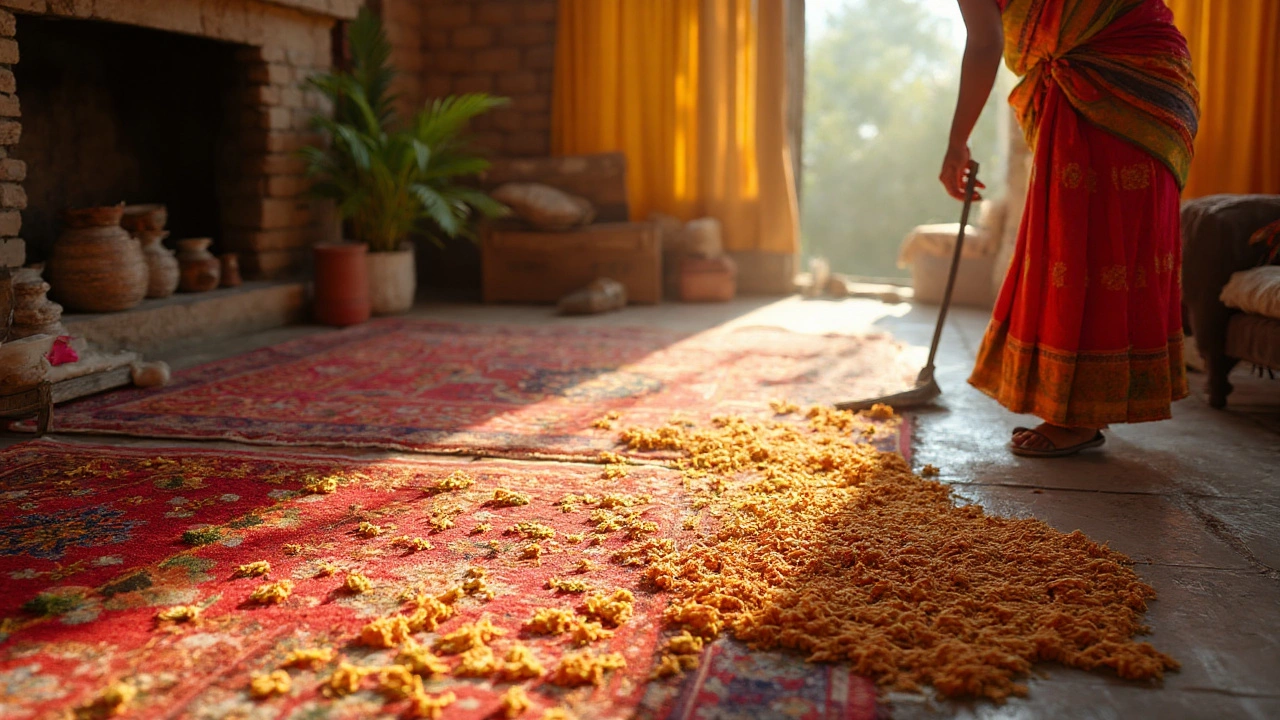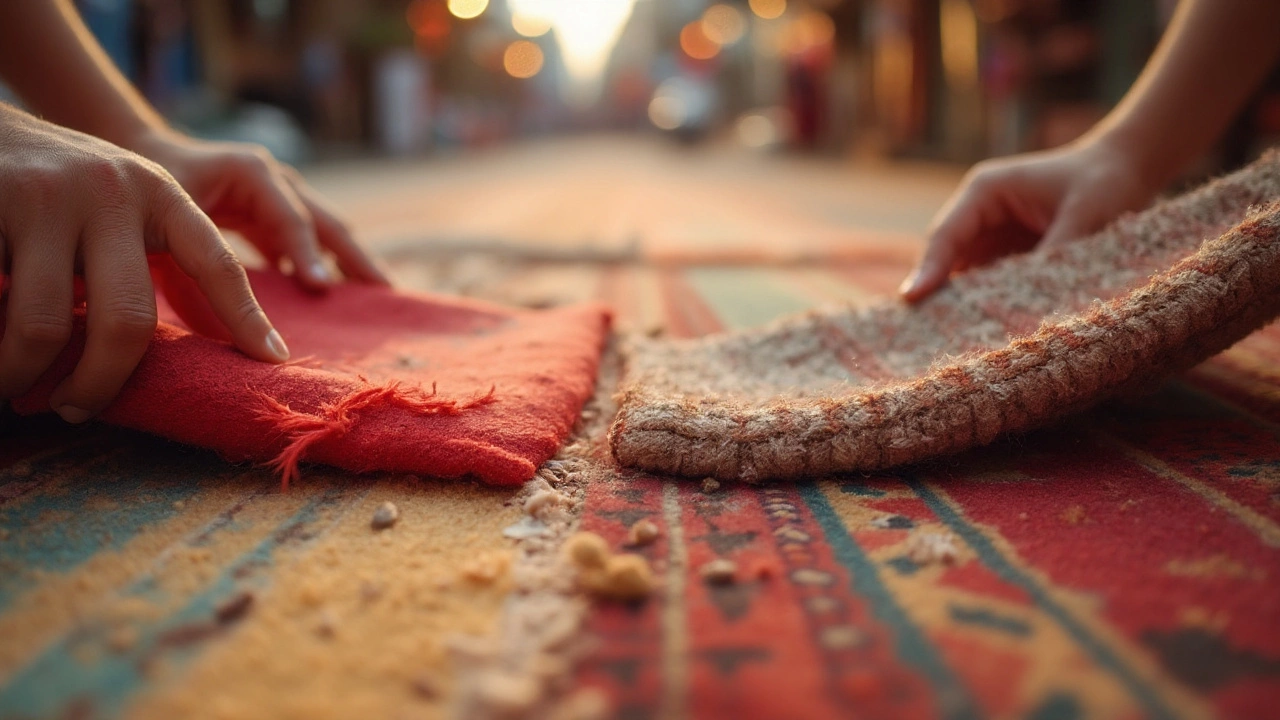Which Rugs Shed the Most? Avoid Messy Carpets With Facts & Pro Tips

If you’ve ever walked barefoot over a new rug and looked down to find your toes covered in loose fibers, you’re not alone. Some carpets are basically fur factories—they shed more than a golden retriever in July. It’s super annoying, right? You vacuum them, you shake them out, and yet there’s always fuzz hanging around. You deserve to know where it comes from, which rugs are the top offenders, and how you can avoid bringing a shedding nightmare into your living room.
Why Do Rugs Shed? The Honest Truth About Those Annoying Fibers
You might assume a bit of fluff is just “breaking in” your new floor accent, but it’s a lot more complicated than that. Shed-happy rugs usually start with their raw materials. Natural wool rugs, especially hand-tufted ones, are famous for dropping fibers everywhere. Wool fibers have little scales along their lengths, kind of like shingles on a roof, which can rub against each other and break off. That’s why your vacuum fills up so fast after you bring one home. And let’s talk construction: hand-tufted rugs are made fast, often with glues and latex rather than careful weaving. The shortcut means more loose fiber, ready to hit the floor. Handmade, hand-knotted rugs, though, go through heavy washing and trimming—less mess, but a much steeper price tag.
Don’t let synthetic options off the hook. Polypropylene and polyester rugs shed too, just not in quite the same way. These plastics don’t love to lose fibers, but if the manufacturing process is sloppy—especially with machine-tufted or low-quality pile—the fibers escape anyway. Yes, even with synthetics you could end up with fluffy socks after one walk around the room. Silk, or the “viscose silk” knockoffs, are (surprisingly) some of the worst: the fibers are delicate, break easily, and leave a fine dust behind. As if that wasn’t enough, new rugs, no matter what they’re made of, always have some loose fibers from cutting and transportation. This initial phase should slow down, unless you’ve got a dud or a low-quality buy.
Here’s a fun fact: rug size and color play a little trick, too. Darker colors make shed fibers show up more, so a navy blue rug might seem like it’s losing hair faster than a cream-colored one—even when they’re made exactly the same. And thicker, deeper pile traps more loose bits, while tightly woven or flatweave styles shrug it off, making cleanup a breeze. All these details come together in whether your rug becomes a daily battle or just part of your style.
Which Rug Materials Shed the Most? Winners (and Losers) in the Shedding Showdown
There’s an all-out battle happening underfoot, and wool is—hands down—the top shedder. Specifically, those soft, fluffy hand-tufted wool rugs you see everywhere. They’re affordable and cozy, but don't be fooled: the latex backings often don’t grip the fibers tightly, so after a few weeks, you’ll see fuzz in every corner. If you want less drama, genuine hand-knotted wool costs more, but those fibers are locked in tight.
Want to see real data? Here’s a quick look at how common rug materials stack up:
| Rug Type | Material | Shedding Level | Notes |
|---|---|---|---|
| Hand-Tufted | Wool | Very High | Often sheds for months |
| Hand-Knotted | Wool | Low | Expensive but durable |
| Machine-Made | Polypropylene | Low | Cheaper, less shedding |
| Handmade | Viscose/Silk | High | Needs delicate care |
| Flatweave (e.g. Kilim) | Wool, Cotton | Very Low | Minimal pile, little to shed |
| Shag | Polyester/Wool | High | Long pile drops fibers easily |
See that? Shag rugs, especially those thick, cozy ones made from polyester or even wool, are fiber-shedding machines. The long pile leads to constant breakage. Viscose (“art silk”) sounds glamorous, but the fibers snap like dried pasta after a few months of foot traffic. On the flip side, look at kilims and dhurries—flatweave rugs made of wool or cotton. They’re practically immune to shedding because there isn’t much pile to lose in the first place. Want the lowest maintenance? Check out indoor-outdoor polypropylene rugs or vintage hand-knotted wool varieties. They’re almost bulletproof when it comes to fuzz on the floor.
One more curveball: New Zealand wool is known for being silky soft, but the fibers are extra fine. That sounds nice in theory, but means more surface area for breaking and, you guessed it, more shedding. If you ever spot a label that brags about “hand-loomed with 100% New Zealand wool” and you can’t stand constant vacuuming, keep moving. Or at least be prepared for a fluffy couple of months.

How to Pick a Rug That (Barely) Sheds: Expert Tips That Actually Work
Shopping for a rug in 2025 is a minefield. You’re bombarded by Instagram influencers flashing fluffy white carpets and interior designers making everything look spotless. Bring home the wrong one, and you’re picking tufts off your pants for a year. So, how do you win?
- Skip anything labeled “hand-tufted wool” with a latex backing. These are notorious for epic shedding problems. If you love wool, go for a genuine hand-knotted rug or a tightly woven flatweave style.
- Ask the store (or scroll online reviews) about the rug’s manufacturing process. Look for mention of “shearing and washing after production”—that’s your best bet for less fuzz.
- When in doubt, pick polypropylene or nylon for a low-maintenance option. These synthetic fibers shed a bit at first, but usually settle quickly. Bonus: they’re great for allergy sufferers and can handle real life—kids, pets, spills, you name it.
- Try to pinch the pile before you buy (or ask for a sample). Gently tug at the ends. Fibers coming loose? Move on. Good pile won’t budge.
- Don’t forget about the style. Flatweave and low-pile rugs are champions in the war against fuzz. High-pile, plush shags? Not so much.
- Pay attention to color. If you pick a dark shade, be aware that any light-colored fibers (or pet hair) will pop against it, even if the rug itself doesn’t shed much. The opposite is true for very light rugs.
- Buy from reputable brands that publish real shedding info or offer free returns. Some will even list "expected shed level" in the description. Avoid sellers that gloss over this detail.
- Be suspicious of “bargain” silk or viscose rugs. They look luxe, but shed like crazy and stain if you even look at them wrong.
- If you’re stuck with a shed-happy rug, vacuum lightly (with the beater bar off) and regularly. Sometimes, shedding slows in a few months—other times, it’s just a permanent feature.
The trick is being honest with your lifestyle. If you have pets, allergies, or hate housework, there's no reason to torture yourself with a rug that acts like it’s molting non-stop. Flatweave or machine-made synthetics will be your best friend.
How to Stop Rug Shedding: What Actually Works and What’s Just Hype?
So you ignored the warnings, brought home a beautiful shaggy rug, and now it’s turning your floors into a snowdrift. First, don’t panic—it happens to the best of us. Food for thought: that “new rug smell” isn’t the only new thing your living room is getting. Shed messes can seem unstoppable, but there are ways to keep the worst of it at bay.
- Vacuum smart, not hard. Go gently, using the lowest suction and skipping the spinning brush if you can. Over-vacuuming (or being rough) can yank out more fibers and make shedding worse.
- Give the rug time. Most new rugs shed a bit right after purchase. Three to six months of light maintenance often tames things, especially with wool, as long as the fibers were properly set.
- Flip the rug and vacuum the backside. This helps release extra fibers without pushing more out of the pile. Once every couple months is fine for this trick.
- Shake it out. If the rug’s not too big, drape it outside over a sturdy railing and go to town. Sometimes, a good shake gets the loose stuff out faster than any vacuum can.
- Try a sticky lint roller for stubborn fibers on the surface. This is also great for spot cleaning after the kids or pets get rough.
- If shedding stays bad for more than a year, it’s probably a structural problem—like a bad glue job or cheap fiber. There’s no magic fix, so replacement might be the sanest move.
Keep this in mind: using a rug pad can help reduce fiber breakage and friction. Pads keep your rug from wiggling around, cutting down on wear. And they’re easier to clean, too. Avoid using harsh chemicals, shampoos, or treatments unless the manufacturer specifically recommends it. Sometimes, those products make the rug shed even more, and who has time for that kind of yard work inside?
Maybe the most honest advice? If you absolutely can’t stand shedding and don’t want to baby a high-end floor piece, flatweave or machine-made rugs in synthetic materials are always, without fail, lower stress. Sure, hand-knotted antique wools are beautiful and a dream if you’ve got the budget and patience. But you’re not missing out on comfort or design if you pick something modern that won’t have you vacuuming every other day. Plus, you get to enjoy your place instead of chasing lint bunnies. That's a win.